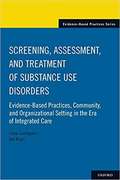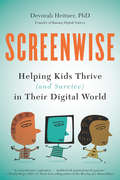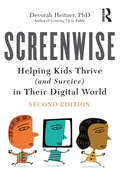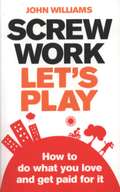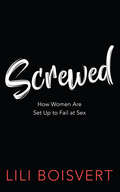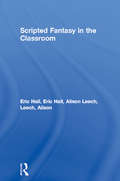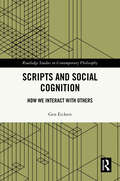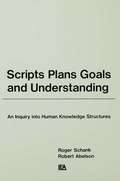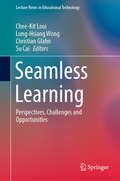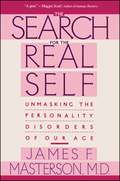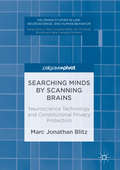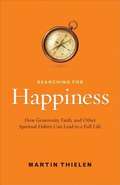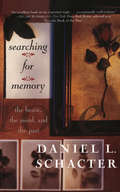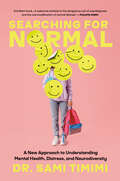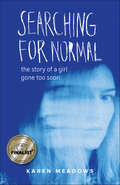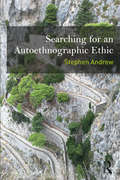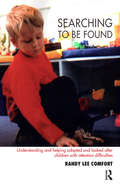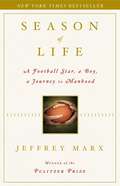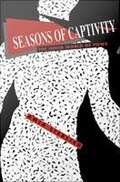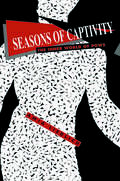- Table View
- List View
Screening, Assessment, And Treatment Of Substance Use Disorders: Evidence-based Practices, Community And Organizational Setting In The Era Of Integrated Care (Evidence-based Practices)
by Lena Lundgren Ivy KrullThere is a clear and pressing need for health professionals, including social workers, to be trained in evidence-based practices (EBPs) in the area of substance use disorders (SUD). The Substance Abuse and Mental Health Services Administration (SAMHSA) and other national organizations and government agencies have all put out reports calling for this vital need, though there remains a significant shortage of properly trained clinicians. The aim of this book is to provide an integrated perspective on addiction treatment on the evidence-base of psychosocial and medication-assisted treatment for substance use disorder. The volume is unique in that it critically examines the evidence base of both psychosocial and pharmacological treatment practices targeting a profession of social work audience. It is also one of few that (1) incorporates evidence both from the United States and internationally, and (2) presents a methodology that permits the authors to systematically review a large number of empirically based studies in an organized and easy-to-read manner. Additionally, the text incorporates a health disparities perspective and describes implementation barriers at the organizational, community, and policy levels. It can be used in policy, human behavior, and clinical practice both nationally and internationall
Screenwise: Helping Kids Thrive (and Survive) in Their Digital World
by Devorah HeitnerScreenwise offers a realistic and optimistic perspective on how to thoughtfully guide kids in the digital age. Many parents feel that their kids are addicted, detached, or distracted because of their digital devices. Media expert Devorah Heitner, however, believes that technology offers huge potential to our children-if parents help them. Using the foundation of their own values and experiences, parents and educators can learn about the digital world to help set kids up for a lifetime of success in a world fueled by technology. Screenwise is a guide to understanding more about what it is like for children to grow up with technology, and to recognizing the special challenges-and advantages-that contemporary kids and teens experience thanks to this level of connection. In it, Heitner presents practical parenting "hacks": quick ideas that you can implement today that will help you understand and relate to your digital native. The book will empower parents to recognize that the wisdom that they have gained throughout their lives is a relevant and urgently needed supplement to their kid's digital savvy, and help them develop skills for managing the new challenges of parenting. Based on real-life stories from other parents and Heitner's wealth of knowledge on the subject, Screenwise teaches parents what they need to know in order to raise responsible digital citizens.
Screenwise: Helping Kids Thrive (and Survive) in Their Digital World
by Devorah HeitnerThe second edition of Screenwise offers a refreshed, realistic, and optimistic perspective on how to thoughtfully guide kids in the digital age. Many parents feel that their kids are addicted, detached, or distracted because of their digital devices. Media expert Devorah Heitner, however, believes that technology offers huge potential to our children—if parents mentor them. Using the foundation of their own values and experiences, parents and educators can learn about the digital world to help set kids up for a lifetime of success in a world fueled by technology. Screenwise is a guide to understanding more about what it is like for children to grow up with technology all around them, and to recognizing the special challenges—and advantages—that contemporary kids and teens experience thanks to this level of connection. In it, Heitner presents practical parenting "hacks": quick ideas that you can implement today that will help you understand and relate to your digital native. The new edition includes updated material and additional strategies for parents and caretakers.
Screenwriting from the Inside Out: Think and Write like a Creative
by Margaret McVeighThis book provides aspiring screenwriters with a practical and informed way to learn how to think and write like a “creative”. It stands apart from, yet complements, other screenwriting “how to” books by connecting the transdisciplinary academic fields of screenwriting, film studies and cognitive psychology and neuroscience. Using a stepped approach, it shows the writer how to understand that how we think, shapes what we write, so that we may write better.
Screw Work, Let's Play: How To Do What You Love and Get Paid For It
by John WilliamsScrew Work, Lets Play will show readers why they will have far greater success, happiness and wealth from playing all day. You're tired of being stuck between boring work that pays and fun stuff that doesn't. You want to be able to do whatever is most fun and exciting for you from day to day, to learn new stuff, to be creative, to express yourself and to do something you actually care about. You want to get paid simply for being you. Screw Work, Lets Play, will show readers why the most successful people in the world do exactly that, just think, Richard Branson, Steve Jobs and Warren Buffet all became billionaires by having fun, and they can too starting right now. This book will help readers discover what they enjoy the most and what playing all day looks like for them. It gives life changing strategies to transform their working lives and reveals the huge variety of ways to get paid and play, not only ensuring more fun, but helping them to increase the amount of money they make.
Screwed: How Women Are Set Up to Fail at Sex
by Lili BoisvertWhen it comes to sex and desire, women are screwed. In film, on the page, in fashion, and in everyday life, women’s desire is routinely shown as subordinate to men’s — when it isn’t suppressed altogether. Lili Boisvert argues that there is one dominant principle behind heterosexual encounters: that desire is a male phenomenon and women are merely its object. To change this alienating system, she contends, we must start by facing it head-on. From clothing to flirting, from our fascination with youth and innocence to the orgasm gap, every aspect of women’s lives is dictated by their status as sex objects. Is it any wonder that they are feeling sexually unfulfilled? In a series of explorations of what desire looks like under patriarchy, Screwed sketches the contours of what could be true sexual liberation for women, inside — and outside — the bedroom.
Scripted Fantasy in the Classroom
by Eric Hall Alison LeechMany teachers have tried simple relaxation techniques in their classrooms and been surprised by their success. This step by step guide to the technique of scripted fantasy shows how the forces of the imagination can be harnessed to improve the social skills and classroom performance of students of all ages and all abilities. It provides sample scripts to get the teacher started, and gives advice on classroom management and on processing the fantasy experience without compromising students' privacy.
Scripting Addiction: The Politics of Therapeutic Talk and American Sobriety
by E. Summerson CarrGaming the language of addiction treatmentScripting Addiction takes readers into the highly ritualized world of mainstream American addiction treatment. It is a world where clinical practitioners evaluate how drug users speak about themselves and their problems, and where the ideal of "healthy" talk is explicitly promoted, carefully monitored, and identified as the primary sign of therapeutic progress. The book explores the puzzling question: why do addiction counselors dedicate themselves to reconciling drug users' relationship to language in order to reconfigure their relationship to drugs?To answer this question, anthropologist Summerson Carr traces the charged interactions between counselors, clients, and case managers at "Fresh Beginnings," an addiction treatment program for homeless women in the midwestern United States. She shows that shelter, food, and even the custody of children hang in the balance of everyday therapeutic exchanges, such as clinical assessments, individual therapy sessions, and self-help meetings. Acutely aware of the high stakes of self-representation, experienced clients analyze and learn to effectively perform prescribed ways of speaking, a mimetic practice they call "flipping the script."As a clinical ethnography, Scripting Addiction examines how decades of clinical theorizing about addiction, language, self-knowledge, and sobriety is manifested in interactions between counselors and clients. As an ethnography of the contemporary United States, the book demonstrates the complex cultural roots of the powerful clinical ideas that shape therapeutic transactions—and by extension administrative routines and institutional dynamics—at sites such as "Fresh Beginnings."
Scripts People Live: Transactional Analysis of Life Scripts
by Claude SteinerWhen Claude Steiner and the late Eric Berne developed the theory of Transactional Analysis, their basic belief that people were born princes and princess, until their parents turned them into frogs” countered the fundamental principle of psychiatry which asserts that emotional and mental distress comes from within. This theory was further developed in Steiner’s book Games Alcoholics Play. Dr. Berne, in What Do You Say After You Say Hello?, acknowledged Steiner’s important role in the analysis of life scripts” which we choose at an early age and which rule every detail of our lives until our death. In Scripts People Live, Steiner expands upon this belief to show that people are innately healthy but develop a pattern early in life based upon negative or positive influences of those around them. Thus children decide, however unconsciously, whether they will be happy or depressed, winners or failures, strong or dependent, and having decided, they spend the rest of their lives making the decision come true. For those who choose a negative script, the consequences can be disastrous unless they make a conscious decision to change. Steiner’s classic in psychological theory, with a new foreword by the author, offers a hopeful and practical analysis so that we all may rewrite our life scripts and lead more meaningful and fulfilling lives.
Scripts and Social Cognition: How We Interact with Others (Routledge Studies in Contemporary Philosophy)
by Gen EickersThis book argues that our success in navigating the social world depends heavily on scripts. Scripts play a central role in our ability to understand social interactions shaped by different contextual factors.In philosophy of social cognition, scholars have asked what mechanisms we employ when interacting with other people or when cognizing about other people. Recent approaches acknowledge that social cognition and interaction depend heavily on contextual, cultural, and social factors that contribute to the way individuals make sense of the social interactions they take part in. This book offers the first integrative account of scripts in social cognition and interaction. It argues that we need to make contextual factors and social identity central when trying to explain how social interaction works, and that this is possible via scripts. Additionally, scripts can help us understand bias and injustice in social interaction. The author’s approach combines several different areas of philosophy – philosophy of mind, social epistemology, feminist philosophy – as well as sociology and psychology to show why paying attention to injustice in interaction is much needed in social cognition research, and in philosophy of mind more generally.Scripts and Social Cognition: How We Interact with Others will appeal to scholars and graduate students working in philosophy of mind, philosophy of psychology, social epistemology, social ontology, sociology, and social psychology.
Scripts, Plans, Goals, and Understanding: An Inquiry Into Human Knowledge Structures (Artificial Intelligence Series)
by Robert P. Abelson Roger C. SchankFirst Published in 1977. Routledge is an imprint of Taylor & Francis, an informa company.
Scum
by Paul Williams'Scum is a masterfully written book in which the author, by means of a particularly effective form of fragmentation of language, captures the disjunctive experience of a terrified boy. The life of the boy and the life of the sentences are lived entirely in the collision of the will to survive and the impossible demands of an incomprehensible, utterly senseless reality. There are no happy endings in Williams' books, but far more valuable is the vitality that is generated in his deft and original use of language.' - Thomas Ogden
Seamless Learning: Perspectives, Challenges and Opportunities (Lecture Notes in Educational Technology)
by Chee-Kit Looi Lung-Hsiang Wong Christian Glahn Su CaiThis book introduces readers to the latest state of research and development in seamless learning. It consolidates various approaches to and practices in seamless learning from a range of techno-pedagogical, socio-situated and socio-cultural perspectives. Further, it details our current understanding of learning in both formal and informal settings, crossover learning, incidental learning, and context-based learning approaches, together with these aspects’ linkages to the notion of seamlessness. The book is divided into sections addressing the theorization of seamless learning, understanding informal learning, research methodological issues, technology-enabled seamless learning and real-world applications of seamless learning. Rounding out the coverage, the final chapter proposes a research agenda for the next 10 years.
Search For The Real Self
by James F. MastersonPersonality disorders--borderline, narcissistic, and schizoid--have become the classic psychological disorders of our age. Outwardly successful, charming and powerful, personality-disordered individuals have long confounded their colleagues, family, lovers and employees--as well as mental health professionals. The author helps the reader understand them. After describing how the healthy real self develops and functions, he explains what can go wrong. Drawing on case histories, he shows how the false self behaves in relationships and on the job, and then delineates appropriate treatments, offering real hope for cure.
Search For The Real Self: Unmasking the Personality Disorders of Our Age
by James F. MastersonPersonality disorders - borderline, narcissistic and schizoid - have become the classic psychological disorders of our age. Outwardly successful, charming and powerful, personality-disordered individuals have long confounded their colleagues, family, lovers and employees - as well as mental health professionals. The author helps the reader understand them. After describing how the healthy real self develops and functions, he explains what can go wrong. Drawing on case histories, he shows how the false self behaves in relationships and on the job, and then delineates appropriate treatments, offering real hope for cure.
Searching Minds by Scanning Brains: Neuroscience Technology and Constitutional Privacy Protection (Palgrave Studies in Law, Neuroscience, and Human Behavior)
by Marc Jonathan BlitzThis book examines the ethical and legal challenges presented by modern techniques of memory retrieval, especially within the context of potential use by the US government in courts of law. Specifically, Marc Blitz discusses the Fourth Amendment’s protections against unreasonable searches and the Fifth Amendment's self-incrimination clause. He also argues that we should pay close attention to another constitutional provision that individuals generally don’t think of as protecting their privacy: The First Amendment’s freedom of speech. First Amendment values also protect our freedom of thought, and this—not simply our privacy—is what is at stake if government engaged in excessive monitoring of our minds.
Searching for Happiness : How Generosity, Faith, And Other Spiritual Habits Can Lead To A Full Life
by Martin ThielenThe key to happiness is being rich, successful, and beautiful…right? Martin Thielen, best-selling author of What's the Least I Can Believe and Still Be a Christian?, insists that this is far from the truth. Happiness, Thielen argues, does not come from external factors like getting a job promotion or finally reaching your goal weight. Rather, happiness is an inside job. <P><P>In brief, easy-to-read chapters, Thielen offers ten traits of happy and fulfilled people. Using psychological research, personal anecdotes, and Scripture, Thielen begins the path to contentment by showing how life circumstances—including income, health, physical appearance, and marital status—only account for about 10 percent of a person's overall life satisfaction. From there, he offers alternatives to the frequent methods we use to make ourselves happy. Instead of aiming to make more money, Thielen contends that expressing gratitude and cultivating optimism are surer paths to joy. Rather than focusing on constant advancement in our careers, let's practice our ability to forgive, to be generous, and to use trials as growth opportunities. These lessons, and much more, help readers who may be dissatisfied in their lives see that authentic contentment is closer than they ever imagined. <P><P>The book features a guide for group or individual study, which includes questions for reflection and a challenge for each individual to reflect on during the week.
Searching for Memory: The Brain, the Mind, and the Past
by Daniel L. SchacterMemory. There may be nothing more important to human beings than our ability to enshrine experience and recall it. While philosophers and poets have elevated memory to an almost mystical level, psychologists have struggled to demystify it. Now, according to Daniel Schacter, one of the most distinguished memory researchers, the mysteries of memory are finally yielding to dramatic, even revolutionary, scientific breakthroughs. Schacter explains how and why it may change our understanding of everything from false memory to Alzheimer’s disease, from recovered memory to amnesia with fascinating firsthand accounts of patients with striking--and sometimes bizarre--amnesias resulting from brain injury or psychological trauma.
Searching for Normal: A New Approach to Understanding Mental Health, Distress, and Neurodiversity
by Sami TimimiFrom an eminent child psychologist, a radical reframing of how we need to think about mental health.What the general public are being told about the nature of mental health is misleading and may be harming our collective sense of well-being. Mental health ideology may be the biggest and most powerful cause of mental health problems today. Dr. Sami Timimi explains why he believes this to be the case and what we can, at an individual and collective level, do about it.More and more people are being diagnosed with ADHD and mental disorders.Young people are being medicalised for behaviours that might be as entirely normal in other parts of the world.Distress has been commodified over many decades by pharmaceutical companies, the media, and the psychiatric establishment.So how can we know when distress is normal and when it is something that needs to be treated?In Searching for Normal, Dr. Timimi explores the political and cultural context of these phenomena and proposes an alternative, a deeply humane approach that looks at the person as a whole--their family context, their culture, their personal resilience--and advocates for a reframing of how we think about and treat distress.
Searching for Normal: The Story of a Girl Gone Too Soon
by Karen MeadowsKaren Meadows had a normal, happy family until depression consumed her daughter, Sadie—a struggle that ended with Sadie’s suicide at age eighteen. In Searching for Normal, Meadows shares her family’s journey as she tries to help her daughter Sadie cope with her mental illness, expertly intertwining her own storyline with excerpts from her daughter’s diaries. The years Meadows chronicles are characterized by Sadie’s heartbreaking bouts of running away, cutting, and living with Portland street families while Karen and her husband desperately search for solutions—trying medication, hospitals, therapy, wilderness and residential treatment programs, and more. Ultimately, however, they find themselves confronted with the devastating shortcomings of the US’s mental health system. Including hindsight advice from Meadows, along with an extensive list of resources that she wishes someone had provided her when she was trying to help Sadie, this book will help parents of struggling teens feel less isolated and better equipped to navigate their teenager’s mental illness. : Meadows also describes recent developments that are paving the way for better diagnoses and treatment options.
Searching for an Autoethnographic Ethic (Writing Lives: Ethnographic Narratives)
by Stephen AndrewThis volume is a call for integrity in autoethnographic research. Stephen Andrew weaves together philosophy, critical theory, and extended self-reflections to demonstrate how and why qualitative researchers should assess the ethical quality of their work. He also offers practical tools designed to limit the likelihood of self-indulgence and solipsism in first-person writing. Equally instructive and exemplary, his work: Is written in a relatable style that draws readers in and encourages them to think critically about the implications and effects of their writing. Examines the history of qualitative and autoethnographic research. Provides implementable strategies for textualizing lived experiences and relationships with others.
Searching to be Found: Understanding and Helping Adopted and Looked After Children with Attention Difficulties
by Randy Lee ComfortA practical, supportive book for adoptive parents, carers, teachers and other professionals who live and work with families and children whose happiness and behaviours are affected by attention difficulties and hyperactivity. The examples of real children and adults in everyday situations translate research findings into meaningful strategies for helping families, teachers and children to find more successful means of managing difficult behaviours and emotions.
Season of Life: A Football Star, a Boy, a Journey to Manhood
by Jeffrey MarxJoe Ehrmann, a former NFL football star and volunteer coach for the Gilman high school football team, teaches his players the keys to successful defense: penetrate, pursue, punish, love. Love? A former captain of the Baltimore Colts and now an ordained minister, Ehrmann is serious about the game of football but even more serious about the purpose of life. Season of Life is his inspirational story as told by Pulitzer Prize-winning journalist Jeffrey Marx, who was a ballboy for the Colts when he first met Ehrmann. Ehrmann now devotes his life to teaching young men a whole new meaning of masculinity. He teaches the boys at Gilman the precepts of his Building Men for Others program: Being a man means emphasizing relationships and having a cause bigger than yourself. It means accepting responsibility and leading courageously. It means that empathy, integrity, and living a life of service to others are more important than points on a scoreboard. Decades after he first met Ehrmann, Jeffrey Marx renewed their friendship and watched his childhood hero putting his principles into action. While chronicling a season with the Gilman Greyhounds, Marx witnessed the most extraordinary sports program he'd ever seen, where players say "I love you" to each other and coaches profess their love for their players. Off the field Marx sat with Ehrmann and absorbed life lessons that led him to reexamine his own unresolved relationship with his father. Season of Life is a book about what it means to be a man of substance and impact. It is a moving story that will resonate with athletes, coaches, parents -- anyone struggling to make the right choices in life.
Seasons of Captivity
by Amia Lieblich"[An] engrossing study, told mainly by the subjects themselves... a valuable addition to POW literature and unique for its positive view of wartime captivity."-Publishers Weekly "Lieblich has skillfully integrated oral histories to produce a compelling story."-Library Journal "The minutes of the meetings recorded hereby are an excerpt of the lives of ten men, who had spent all their days and nights together. Each one observed the other in his grief and joy.Each one, according to his ability and sensitivity, saw it as his duty to contribute to the general welfare, to save our boat from sinking....In fact, we managed to keep afloat most of the time, and if we erred here or there, at least we had the best intentions."-From a secret collective diary kept by ten POWs A national bestseller when it first appeared in Israel, Seasons of Captivity is a story of human survival and hope that documents the experience of ten Israeli prisoners of war who shared a single jail cell in Egypt for more than three years. The engrossing chronicle of the prisoners' ordeal is told in their own words-from their capture in 1969, through six months of interrogation, torture, and isolation, to their movement to a common room. A watershed event, their transfer to shared living quarters enabled them to forge a community and an almost utopian social system. They held weekly meetings, kept a common diary, started study classes, and, among other projects, translated The Hobbit into Hebrew. The narrative goes on to describe the re-entry of the POWs into family and social roles upon their release and return to Israel in 1973. An exploration of the personal impact of the experience on the wives of the married prisoners introduces the women's own stories of separation and reunion. Some of them had suddenly found themselves, in effect, single mothers-yet their husbands were alive. Their husbands found stronger, more independent women in place of the traditional ones they had left behind. One of the women remarks, I thought [my husband] had been angry at me, in part unconsciously, for being so strong and competent in his absence...I had managed, well, almost effortlessly. This dramatic and moving account illustrates the resilience of the human spirit in the face of the most dehumanizing circumstances.
Seasons of Captivity: The Inner World of POWs
by Amia Lieblich"[An] engrossing study, told mainly by the subjects themselves... a valuable addition to POW literature and unique for its positive view of wartime captivity."-Publishers Weekly "Lieblich has skillfully integrated oral histories to produce a compelling story."-Library Journal "The minutes of the meetings recorded hereby are an excerpt of the lives of ten men, who had spent all their days and nights together. Each one observed the other in his grief and joy.Each one, according to his ability and sensitivity, saw it as his duty to contribute to the general welfare, to save our boat from sinking....In fact, we managed to keep afloat most of the time, and if we erred here or there, at least we had the best intentions."-From a secret collective diary kept by ten POWs A national bestseller when it first appeared in Israel, Seasons of Captivity is a story of human survival and hope that documents the experience of ten Israeli prisoners of war who shared a single jail cell in Egypt for more than three years. The engrossing chronicle of the prisoners' ordeal is told in their own words-from their capture in 1969, through six months of interrogation, torture, and isolation, to their movement to a common room. A watershed event, their transfer to shared living quarters enabled them to forge a community and an almost utopian social system. They held weekly meetings, kept a common diary, started study classes, and, among other projects, translated The Hobbit into Hebrew. The narrative goes on to describe the re-entry of the POWs into family and social roles upon their release and return to Israel in 1973. An exploration of the personal impact of the experience on the wives of the married prisoners introduces the women's own stories of separation and reunion. Some of them had suddenly found themselves, in effect, single mothers-yet their husbands were alive. Their husbands found stronger, more independent women in place of the traditional ones they had left behind. One of the women remarks, I thought [my husband] had been angry at me, in part unconsciously, for being so strong and competent in his absence...I had managed, well, almost effortlessly. This dramatic and moving account illustrates the resilience of the human spirit in the face of the most dehumanizing circumstances.
